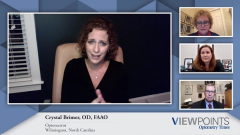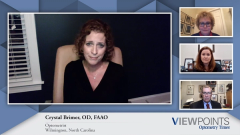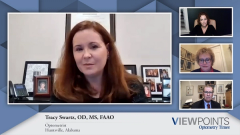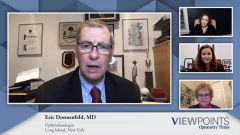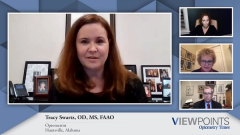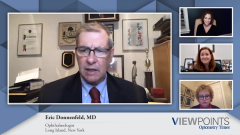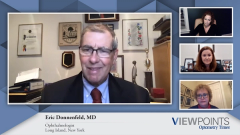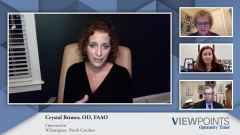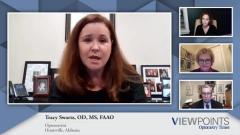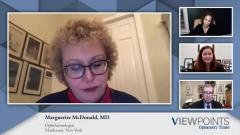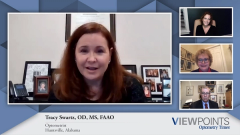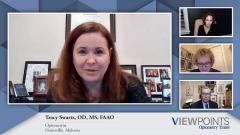
Challenges in the management of DED
Episodes in this series

Marguerite McDonald, MD: Eric, what do you think the biggest challenge is that eye care providers face in identifying dry eye disease? How can we streamline the diagnosis, and what role do your technicians play in identifying the patients with dry eye?
Eric Donnenfeld, MD: If I had to say, the greatest challenge for eye care providers for dry eye is apathy. It’s not caring enough about a serious condition and you need to get more invested in it. But to do that, we’ve really taken the responsibility of diagnosing dry eye in many ways out of the hands of the eye doctor and put it in the hands of our staff and technicians, who listen to the patients, and we have them do the testing that is deemed appropriate for these patients. So the patient comes in with all the tests necessary to make a very rapid diagnosis. Streamlining the diagnosis, I think is key, and I’m looking forward to new biomarkers that are coming out in the near future that will make diagnosis of dry eye easier and more reproducible. I think that will allow us to treat more effectively as well.
It’s been brought up by several of my colleagues here tonight, but again, I think the key to diagnosing dry eye is to differentiate between aqueous deficiency and meibomian gland disease, and very commonly patients have both. But you need to treat the appropriate form of dry eye. For 10 years, when all we had was Restasis, it was like all we had was a hammer and everything looked like a nail. You need to treat the appropriate disease. Treating meibomian gland disease when the patient has aqueous-deficiency dry eye isn’t that effective. So you need to diagnose the dry eye effectively, do the proper testing, let your technicians play a role, get the testing done, facilitate the movement of the patients through the office, make it a faster visit, and then spend more time caring for the patient. I think this is the place where optometry and ophthalmology need to work better together. In a busy ophthalmic practice where there may not be the time that’s necessary for counseling patients or for following them as closely as they should, you need to have a colleague who you can hand the patient off to, who will spend the time and effort that’s needed to make these patients happy, and to make sure that they follow up with their disease management.
Marguerite McDonald, MD: Great. Crystal, what do you think are the biggest challenges that eye care professionals face in managing dry eye disease, and how big of a problem do you think is patient adherence and compliance?
Crystal Brimer, OD, FAAO: That is one of the biggest challenges we face. I think the other one is cost and continually balancing those two. When it comes to the compliance issue, I preach all the time that everything stems from that. You could have the best treatment in the world, but if you don’t have compliance, you’re not going to get the outcome. The way I managed to get the compliance was through an effective patient communication and patient education piece. It used to be much harder for me to get that compliance, and now I feel like it’s not work because, again, I’m the messenger. I’m using effective patient communication and being able to show them and tell them that story, and that creates the compliance because they understand the why. No. 1, patient education and setting expectations; No. 2, keeping it simple, keeping the plan simple; and No. 3, really encouraging and adapting when they come back. When they come back, show them the things that are better, get excited, because they may not feel it yet. But I need them to know that I can see it, so that they keep holding on to the treatment plan because it’s working. I think those 3 things together have done wonders for patient compliance in my office. I know everybody has their own recipe.
The other thing that I’ve done recently, I wrote a book that was 120 pages. I use the term book loosely, but it is bound, and it’s all about the lifestyle, and here’s how lack of sleep affects your outcomes, here are 31 ways to get better sleep. Here’s how stress affects it, here are 16 ways to reduce stress. Here are supplements to help with that, here are inflammatory foods, all these things. Then it has a section on categories: for an oil problem, the better/best solution. Water, better/best. Inflammation, good/better/best. All the brochures that I would normally run around the office and give, they’re in the back of the book. This has really helped because they see me as a partner with them. They know that my heart is in it and that I’m bringing everything to the table, and I expect the same from them. It’s really about accountability on each side.
Newsletter
Want more insights like this? Subscribe to Optometry Times and get clinical pearls and practice tips delivered straight to your inbox.


